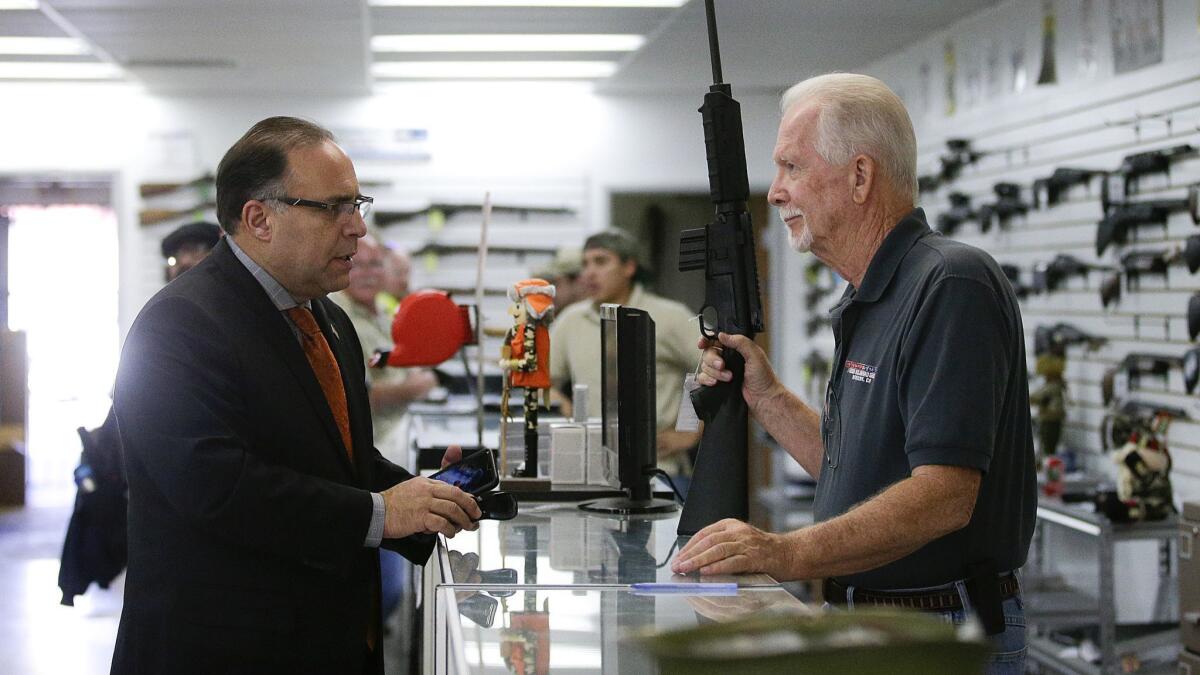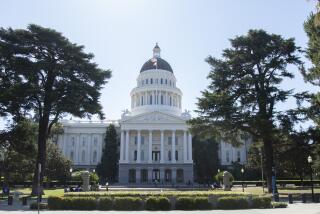Editorial: A tax on California gun sales? It’s worth considering

- Share via
The social costs of gun ownership in the U.S. have reached staggering levels, though given the lack of reliable data collection the public is left to sift through conflicting estimates of the numbers of firearms Americans actually own.
One survey-based estimate places the number at 265 million guns and another suggests 393 million guns; the larger number, if accurate, would account for nearly half of the civilian-owned guns in the world. According to a Johns Hopkins University study, U.S. emergency room and in-patient medical visits for gunshot wounds alone cost about $2.8 billion a year; it’s $45 billion if you count lost wages. Mother Jones magazine estimated the annual total costs from gun violence, including medical, law enforcement, trials and other costs, at $229 billion.
A few local governments have tried to find a way to make all those gun owners pay a little more toward those associated costs through taxes on guns and ammunition. Levies of $25 per gun sale and up to a nickel per round of ammunition are in effect in Seattle and Cook County, Ill. Similar efforts to establish a California tax on guns and ammunition have cropped up in the past, and Assemblyman Marc Levine (D-San Rafael) on Monday introduced AB 18 to establish a tax — at an unspecified rate — on handguns and semiautomatic rifles sold in the state, one that might expand to include a tax on ammunition. Making gun owners shoulder a little more of the cost of gun violence is an interesting idea worthy of consideration, though the final shape of such a bill will determine how much support it deserves.
Making gun owners shoulder a little more of the cost of gun violence is an interesting idea worthy of consideration.
But first there’s a fundamental hurdle to clear. Much as we disagree with it, the U.S. Supreme Court ruled in the 2008 Heller decision that the 2nd Amendment confers a right to own a firearm in the home for self-protection. Since it is a court-recognized constitutional right, a tax that is too onerous — and which is designed to deter people from exercising that right — could create a problem. What is too onerous? Well, that’s unclear. The Northern Mariana Islands, a U.S. territory in the Pacific, approved a $1,000 tax on pistols in 2016 in a clear effort to use tax codes to limit gun sales; a federal judge later struck down the tax because it “places an excessive burden on the exercise of the right of law-abiding citizens to purchase handguns for self-defense without a corresponding important government interest.”
But other courts have upheld a $25 tax as non-punitive. Guns range wildly in price, but handguns tend to average in the $500 to $550 range. A Rand Corp. study found that increased fees for hunting licenses did not affect the number of people who hunt, and the Cook County tax didn’t reduce gun sales there. Fewer than a third of Americans own a firearm (and 29% of those own five or more guns), according to the Pew Research Center. It seems unlikely that an additional $25 per gun — or $50 for that matter — would unduly restrict their ability to buy a firearm.
Enter the Fray: First takes on the news of the minute from L.A. Times Opinion »
But is it a wise tax? How much money might be generated will be influenced by what firearms are covered. Levine is proposing that long guns used for hunting not be subject to the tax, though it’s unclear how many such guns are sold in California each year. What we do know is that over the last five years, an average of 503,000 handguns have been sold each year, as have 556,000 long guns, including hunting rifles, shotguns and assault weapons. If just handguns had been covered, a $25 tax would have raised $12.6 million per year; if all the guns were covered, that would have raised $26.5 million a year.
AB 18 would direct the new revenues to the state’s existing $9.2-million California Violence Intervention and Prevention Program that offers grants to community organizations mounting effective gun-violence prevention programs. It might be more pragmatic to make the distribution of the proposed tax revenues wider and include medical facilities that bear some of the costs of caring for gun violence victims, but fundamentally it is a good idea to tie the revenues to specific gun-related uses so the money doesn’t disappear into the general fund. The Legislature should give this proposal serious consideration, and take care that whatever final form it takes will survive the inevitable legal challenge from the gun lobby.
Follow the Opinion section on Twitter @latimesopinion or Facebook
More to Read
A cure for the common opinion
Get thought-provoking perspectives with our weekly newsletter.
You may occasionally receive promotional content from the Los Angeles Times.









